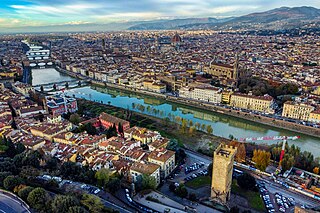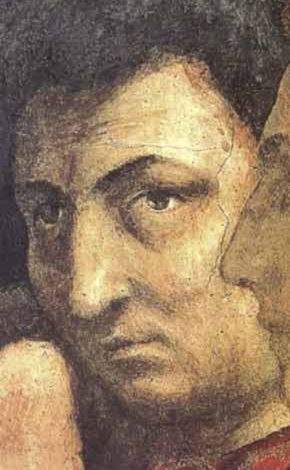
Fra Angelico, OP was a Dominican friar and Italian Renaissance painter of the Early Renaissance, described by Giorgio Vasari in his Lives of the Artists as having "a rare and perfect talent". He earned his reputation primarily for the series of frescoes he made for his own friary, San Marco, in Florence, then worked in Rome and other cities. All his known work is of religious subjects.

Florence is the capital city of the Italian region of Tuscany. It is also the most populated city in Tuscany, with 360,930 inhabitants in 2023, and 984,991 in its metropolitan area.

Paolo Uccello, born Paolo di Dono, was an Italian painter and mathematician who was notable for his pioneering work on visual perspective in art. In his book Lives of the Most Excellent Painters, Sculptors, and Architects, Giorgio Vasari wrote that Uccello was obsessed by his interest in perspective and would stay up all night in his study trying to grasp the exact vanishing point. Uccello used perspective to create a feeling of depth in his paintings. His best known works are the three paintings representing the battle of San Romano, which were wrongly entitled the Battle of Sant'Egidio of 1416 for a long period of time.

Masaccio, born Tommaso di Ser Giovanni di Simone, was a Florentine artist who is regarded as the first great Italian painter of the Quattrocento period of the Italian Renaissance. According to Vasari, Masaccio was the best painter of his generation because of his skill at imitating nature, recreating lifelike figures and movements as well as a convincing sense of three-dimensionality. He employed nudes and foreshortenings in his figures. This had seldom been done before him.

The Uffizi Gallery is a prominent art museum located adjacent to the Piazza della Signoria in the Historic Centre of Florence in the region of Tuscany, Italy. One of the most important Italian museums and the most visited, it is also one of the largest and best-known in the world and holds a collection of priceless works, particularly from the period of the Italian Renaissance.

Giorgio Vasari was an Italian Renaissance painter, architect, art historian and biographer, who is best known for his work Lives of the Most Excellent Painters, Sculptors, and Architects, considered the ideological foundation of all art-historical writing, and still much cited in modern biographies of the many Italian Renaissance artists he covers, including Leonardo da Vinci and Michelangelo, although he is now regarded as including many factual errors, especially when covering artists from before he was born.

Domenico di Tommaso Curradi di Doffo Bigordi, professionally known as Domenico Ghirlandaio, was an Italian Renaissance painter born in Florence. Ghirlandaio was part of the so-called "third generation" of the Florentine Renaissance, along with Verrocchio, the Pollaiolo brothers and Sandro Botticelli.

The Palazzo Vecchio is the town hall of Florence, Italy. It overlooks the Piazza della Signoria, which holds a copy of Michelangelo's David statue, and the gallery of statues in the adjacent Loggia dei Lanzi.

Raffaellino del Garbo (1466–1527) was a Florentine painter of the early Renaissance.

Giuliano di Piero di Simone Bugiardini was an Italian Renaissance painter. He was born and was mainly active in Florence. He was a painter primarily of religious subjects but he also executed a number of portraits and a few works with mythological subjects.

Sister Plautilla Nelli (1524–1588) was a self-taught nun-artist and the first ever known female Renaissance painter of Florence. She was a nun of the Dominican convent of St. Catherine of Siena located in Piazza San Marco, Florence, and was heavily influenced by the teachings of Savonarola and by the artwork of Fra Bartolomeo.

Lorenzo di Bicci was an Italian painter of the Florentine School considered to be one of the most important painters in Florence during the second half of the 14th century. He is believed to have learned his trade from his father, about whom little is known. Lorenzo’s style, as well as that of his contemporaries Jacopo di Cione and Niccolò di Pietro Gerini, was influenced by the artist Andrea di Cione. Lorenzo's paintings made use of bright colors and his compositions avoided complexity. The figures he painted tended to have round faces and were often expressionless. Another one of Lorenzo's distinctive characteristics was his precision of execution. He was known for exceptional talent in drawing, an ability that he put to use at the initial stages of his painting. Unlike many celebrated Florentine artists of this period, Lorenzo mostly received commissions from the country clergy and from the lower-middle-class Florentine guilds. His successors, Bicci di Lorenzo and Neri di Bicci, continued to serve these groups.
Richard Christian Wynne Fremantle was an American art historian. The focus of most of his work is the early Florentine Renaissance, and in particular, the painter Masaccio.

Zanobi di Benedetto di Caroccio degli Strozzi, normally referred to more simply as Zanobi Strozzi, was an Italian Renaissance painter and manuscript illuminator active in Florence and nearby Fiesole. He was closely associated with Fra Angelico, probably as his pupil, as told by Vasari. He is the same painter as the Master of the Buckingham Palace Madonna. Most of his surviving works are manuscript illuminations but a number of panel paintings have also been attributed to him, including seven altarpieces and six panels with the Virgin and Child, along with some designs for metalwork.
Invisible Women: Forgotten Artists of Florence is a 2009 book in English and Italian by Jane Fortune through the Advancing Women Artists Foundation (AWA) and published by The Florentine Press. The book describes the history of female artists in Florence and their hundreds of works in the city's museums or storehouses. AWA has rediscovered at least 2,000 works by women artists that have been forgotten in museum attics and churches of Florence, and they have restored more than 60 paintings so far. Contributing authors include Linda Falcone, Serena Padovani, Rosella Lari and Sheila Barker. It has twenty-six chapters on thirty-five women artists active in Florence.
Advancing Women Artists Foundation (AWA) was an American not-for-profit organization, with headquarters in Indianapolis, Indiana, and Florence, Italy. AWA is committed to identifying and restoring artwork by Florence's female artists in the city’s museums, churches, and storehouses. The foundation achieves its mission through sponsoring restoration of artwork, and promoting research on female artists. As of 2018, AWA has restored 61 paintings and sculptures from the 15th century to the 19th century. It supports the creation of educational materials and events, including books, television documentaries, seminars, and conferences.
Jane Fortune was an American author and journalist. Many of her publications and philanthropic activities were centered on the research, restoration, and exhibition of art by women in Florence, Italy.

Félicie de Fauveau was a nineteenth-century French sculptor who was a precursor of the pre-Raphaelite style. She worked in a variety of techniques and mediums, including marble, stone, glass and bronze.
Antonia di Paolo di Dono (1456–1491) was the daughter of Paolo di Dono, nicknamed Uccello, a well-known early Renaissance Florentine painter. Giorgio Vasari's biography of Uccello states that he had "a daughter who knew how to draw." Antonia was recorded in the Libro dei Morti of the painter's guild, Arte dei Medici e Speziali, as a "pittoressa." This was the first time the feminine form of the word "painter" appears in Florentine public records and the first formal recognition of a fifteenth-century woman artist.














